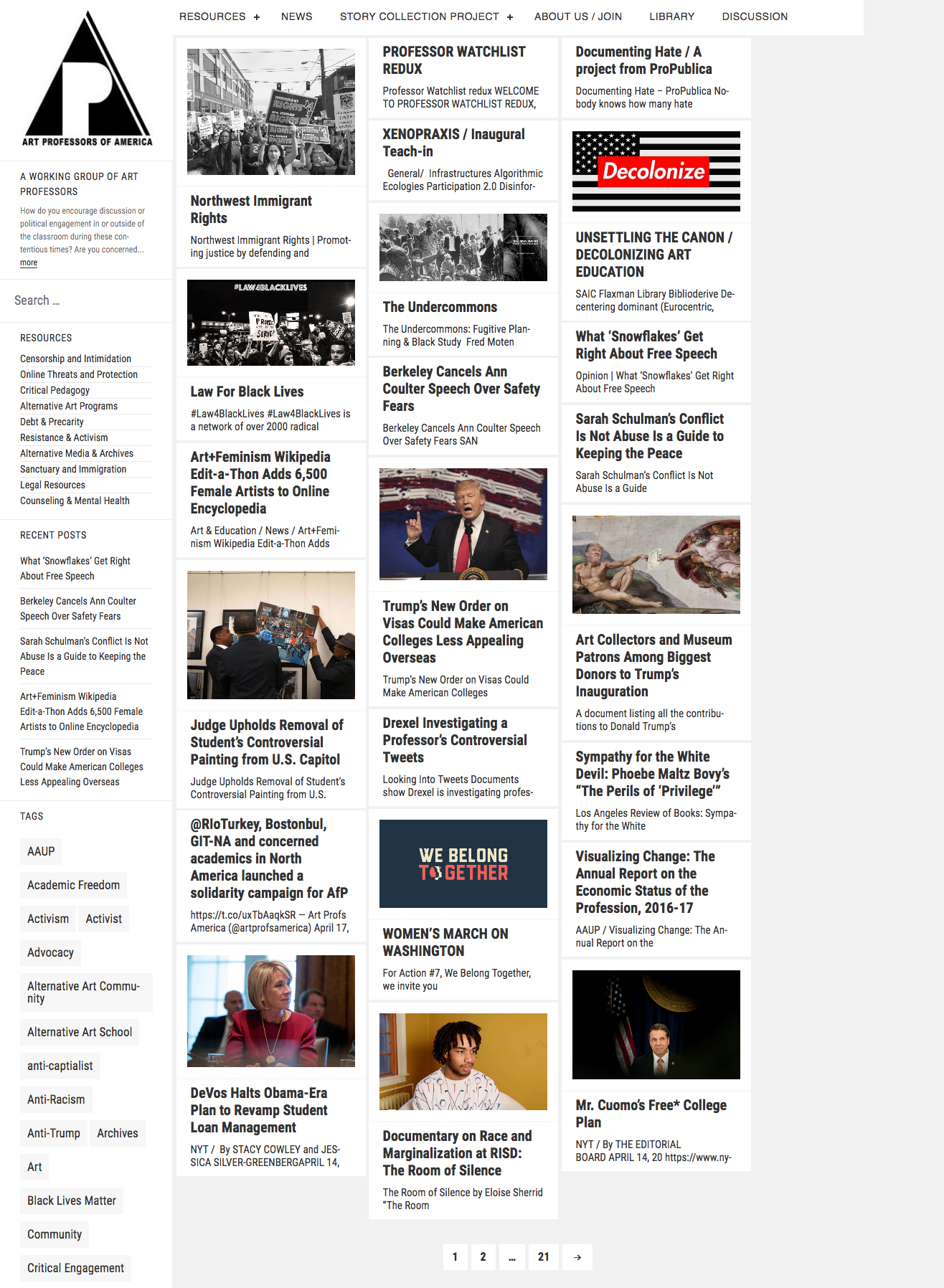CAA News Today
Art Professors of America Interview
posted by Christopher Howard — Apr 25, 2017
 CAA recently corresponded with Marc Handelman, an artist and assistant professor of visual arts for the Mason Gross School of the Arts at Rutgers University in New Brunswick, New Jersey, about a new grassroots organization concerned with advocacy issues, called the Art Professors of America.
CAA recently corresponded with Marc Handelman, an artist and assistant professor of visual arts for the Mason Gross School of the Arts at Rutgers University in New Brunswick, New Jersey, about a new grassroots organization concerned with advocacy issues, called the Art Professors of America.
When and why did the Art Professors of America form? What are its goals?
A couple of dozen art professors from several schools in the Northeast came together in the wake of the election initially to discuss how we might respond to a right-wing campaign to blacklist liberal and progressive faculty by smearing them as un-American. Simultaneously, many of us were seeing a troubling uptick both of threats and attacks on Latino, Muslim, and LGBTQ students, and of anti-Semitism on campuses. Some of us were also experiencing increased feelings of anxiety and self-censorship. Most of all, we felt the urgency and need of being together and sharing our experiences as artists and educators and citizens. We decided to meet every two weeks in New York and continue the conversation. Because colleagues from around the country reached out to be part of the dialogue, we started an email group that now represents professors in well over a dozen states. We are currently working on expanding this network to all fifty states, welcoming art professors of all ranks and teaching status, including TAs and those between positions. Our primary goal right now is to be a platform that connects people nationally and shares critical information. Our latest project was the launch of our website that features news related to education in our political climate and a critical resource page.
What is the purpose of the advocacy resource APA is building?
There are many potential and actual threats that faculty are facing increasingly. Some of these issues begin at the state level, where funding for classes or entire programs are being cut due to their political content. Other issues range from online harassment to deceptively progressive legislation for free-speech protection on campus. Meanwhile, higher education in general continues to foster crippling student debt as institutions struggle to deal with increasing demands for greater diversity, inclusion, and equity. The resource page we launched and continue to build on modestly attempts to provide critical information and tools to help us deal with some of these problems, from distributing information about student loans for undocumented students to debt models in art education. Other items provide online security protocol and consent laws for recording in classrooms. Some of the categories include Censorship and Intimidation, Critical Pedagogy, Alternative Art Programs, Debt and Precarity, Sanctuary and Immigration, and Legal Resources, among others.
Where do the resources come from?
Nearly all of the content already exists online in some form, from other organizations and studies. Populating the website was an extensive three-month process of collecting information and links and aggregating them in these categories. We have been so grateful to other working groups and colleagues for sharing their resources as well.
What are the most urgent issues confronting art professors in the United States today?
Clearly we don’t assume to speak for every program. But in the immediate context, the travel ban and ICE deportations may have the most immediate effects on our students, faculty, and visiting artists. Academic freedom has been under various levels of threat for a long time, and it remains to be seen how deeply and broadly new threats develop. But economic precarity and inequality remain the most pressing structural issue in education both for art schools and the larger university system. This affects part-time adjuncts who, already underpaid, are increasingly asked to do things such as decrease their course loads so as not to trigger contingent benefits, the end of tenured lines, and students who suffer under crippling debt or have no access to higher education at all. Critical and progressive curricula can’t make up for the undergirded issues of access, which are directly tied to geography, race, and class.
Under this current political regime, arts faculty may actually have a greater deal of security than professors and departments researching and teaching social justice, antiracism, and climate change. We need to continually find ways to support our colleagues in other fields.
How can CAA members get involved?
We welcome new arts-affiliated adjuncts, TAs, and professors into our organization and dialogue—the more voices represented, the better. Members will have access to group documents and files, as well as The Story Collection Project, which shares and archives testimonials and stories about what is happening in different corners of our campuses and in classrooms across the country. Meanwhile, the Art Profs America website, offering news, links, and resources, is live and available to anyone online. Please feel free to share with other colleagues as well. You can visit us, or join at http://artprofsamerica.com.
To request to join the discussion, please visit https://groups.google.com/d/forum/art-profs-america. You may also follow APA on Twitter.


